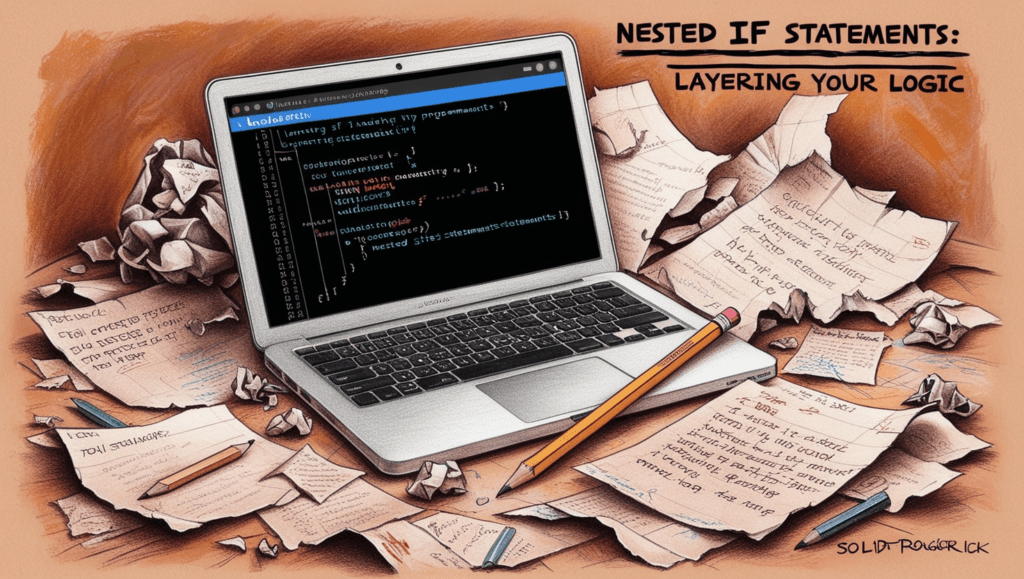Solidity Tutorial Chapter 5 : Welcome back, Solidity wizards! We’ve covered some cool stuff so far, like functions and data types, but now it’s time to dive into one of the most fun and powerful aspects of coding: conditionals. Yep, these little guys help you control the flow of your smart contracts, kind of like how you decide between Netflix or a night out (well, mostly Netflix, let’s be real!). In this chapter, we’ll be breaking down Solidity conditionals step-by-step in a super casual way, so no need to feel overwhelmed!
What Are Conditionals? Think of Them as Your Code’s Brain
Conditionals are basically the “decision-makers” of your smart contract. They help your code make choices based on the conditions you set up. Imagine you’re programming a vending machine (yum!). If you put in enough money, it gives you the snack. If not, it just sits there like, “Nope!” Conditionals do the same in coding—they evaluate whether something is true and decide what action to take.
Why Should You Care About Conditionals?
You don’t just want a robot that does one thing, right? With Solidity conditionals, you can make your smart contracts more dynamic. Like, say you’re building a dApp (decentralized app) for a game. You might want to code something like, “If the player’s score is above 100, reward them with a bonus.” Without conditionals, your contracts are just dull robots doing the same thing over and over.
In short, conditionals in Solidity let you add intelligence to your code. They’re the heart of the decision-making process in your smart contracts!
The If-Else Statement: Your Go-To Conditional

Alright, let’s kick things off with the most basic form of conditionals—the if statement. It’s the bread and butter of decision-making in coding. If a condition is true, something happens. If it’s false, something else happens. Let’s break it down into an easy example.
if (condition) {
// Do this if the condition is true
} else {
// Do this if it’s false
}Let’s throw this into action with a real-life scenario:
pragma solidity ^0.8.0;
contract MyFirstContract {
uint public age = 18;
function checkAge() public view returns (string memory) {
if (age >= 18) {
return "Congrats, you can vote!";
} else {
return "Oops, you're not old enough.";
}
}
}In this example, our function checks if the age is greater than or equal to 18. If yes, it returns the string “Congrats, you can vote!” If not, it returns “Oops, you’re not old enough.”
Taking It Up a Notch: Else-If Statements
What if you have more than two outcomes? No worries! Else-if to the rescue! This allows you to test multiple conditions. Let’s say you want to return different results depending on the age.
function checkAge() public view returns (string memory) {
if (age >= 65) {
return "You're a senior citizen!";
} else if (age >= 18) {
return "You can vote!";
} else {
return "You're still too young.";
}
}Here, depending on the value of age, the function will return one of three different strings. If the age is 65 or older, you’ll see “You’re a senior citizen!” If it’s between 18 and 64, it says “You can vote!” Otherwise, it’ll tell you “You’re still too young.“
Comparison Operators: The Real Magic of Conditionals

Now that you’ve got the basic structure down, it’s time to talk about comparison operators. These let you compare values and decide what actions to take. You’ve already seen some in action (like >=), but here’s the full lineup:
==: Is equal to!=: Is not equal to>: Greater than<: Less than>=: Greater than or equal to<=: Less than or equal to
Let’s go ahead and use these operators in another example:
function compareNumbers(uint num1, uint num2) public pure returns (string memory) {
if (num1 > num2) {
return "First number is larger!";
} else if (num1 == num2) {
return "Both numbers are equal!";
} else {
return "Second number is larger!";
}
}Here, we’re comparing two numbers, and the function will return a message based on which number is larger or if they’re equal. Simple, right?
Logical Operators: The Secret Sauce for Advanced Conditionals
Want to combine conditions? No problem! Logical operators help you test multiple conditions at once. These are the main logical operators you’ll use in Solidity:
&&: AND – all conditions must be true||: OR – at least one condition must be true!: NOT – reverses the condition
Let’s say you want to check both age and citizenship status for voting eligibility:
function checkEligibility(uint age, bool citizen) public pure returns (string memory) {
if (age >= 18 && citizen == true) {
return "You are eligible to vote!";
} else {
return "You are not eligible to vote.";
}
}In this example, we’re using the && operator to check if both conditions (age and citizenship) are true. If both are, it returns “You are eligible to vote!” If either is false, it returns “You are not eligible to vote.“
Nested If Statements: Layering Your Logic

Now, let’s get a little fancier with nested if statements. This is when you put an if statement inside another if statement. Don’t panic—it’s not as complex as it sounds!
function checkNumber(uint num) public pure returns (string memory) {
if (num > 10) {
if (num < 20) {
return "Number is between 10 and 20";
} else {
return "Number is greater than 20";
}
} else {
return "Number is 10 or less";
}
}In this example, we first check if the number is greater than 10. If so, we then check if it’s less than 20. This lets you create layers of conditions to handle different scenarios.
Ternary Operator: The Shortcut for If-Else
Feeling lazy? Don’t worry, Solidity has you covered with the ternary operator. This is like an if-else statement squished into one line. It looks like this:
(condition) ? trueResult : falseResult;Check out this example that determines if a number is even or odd:
function checkEvenOrOdd(uint num) public pure returns (string memory) {
return (num % 2 == 0) ? "Even" : "Odd";
}Here, we’re using the ternary operator to check if a number is even. If it is, we return “Even“. Otherwise, we return “Odd“. Simple, right?
Wrapping It Up: Why You Should Love Conditionals
Conditionals are the backbone of decision-making in your smart contracts. With if-else statements, comparison operators, and logical operators, you can create powerful and dynamic logic that adapts based on real-time input. This is key for building everything from decentralized applications to complex smart contracts.
Whether you’re just starting out with Solidity or you’re already knee-deep in code, conditionals are a must-learn. Now that you’ve got a solid understanding of how they work, go ahead and experiment in your projects.
In our next chapter, we’ll take it up another level and explore loops in Solidity, which will allow your smart contracts to handle repetitive tasks like a pro. Stay tuned for more!


